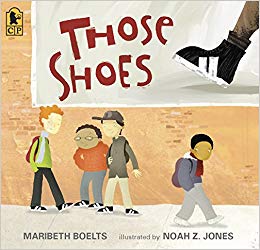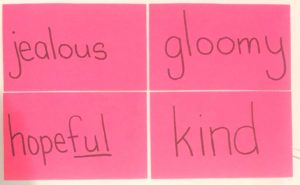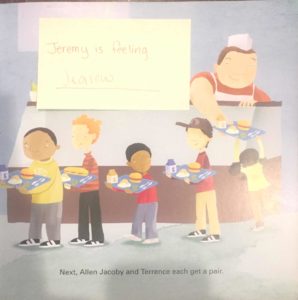Okay, confession, I’ve had this one for A LONG time! I love this story because it’s easily relatable for the kids and I’ve never had a student not enjoy reading it!
Why I Finished It:
This story is about a little boy, Jeremy, who desperately wants the same black high tops as everyone else (see – relatable), but his Grandma can’t afford them. He goes through a series of events trying to obtain the shoes only to realize something more important than having the shoes. For an adult, it is a story that is easy to figure out; for students, it is a complex story that is totally manageable!
Who I Would Give It To:
This is one of my favorite books to use in Guided Reading (it’s marked as a level L) and in social studies. I really think all elementary classrooms should have this book. Not only is it enjoyable, but there is so much you teach with this mentor text.
Integration Ideas:
Social Studies – Needs and Wants (Economics)
In early elementary economics, students are learning about needs and wants. I usually have students talk about what they need to survive versus what they like. There are always some items that always spark interesting conversations, like medication, cars, etc. I have students make collages or I tech it up with multimedia presentations or a tool like FlipGrid.
This picture book is the perfect mentor text to help illustrate this social studies concept. Jeremy really WANTS the shoes that everyone else has, but really he just NEEDS shoes. The emotion and the human desire to be like everyone else makes this decision hard to accept. As we read through the story (small group or whole class), we stop and discuss what the needs are and what the wants are. With older students, we have discussed whether wants and needs are different for wealthier people and if that’s fair. This was a POWERFUL discussion!
Character Analysis
When teaching character, it is important to front-load vocabulary. It is also extremely important to differentiate between character traits and character feelings. A person or character can be honest, but their feelings can and will change many times. In other words, an honest person can be scared, or thrilled, or depressed. In this book, Jeremy will go through a host of emotions as he desires shoes that they can’t afford, possibly finds a pair, (but they’re too small), and then makes a tough decision.
character traits and character feelings. A person or character can be honest, but their feelings can and will change many times. In other words, an honest person can be scared, or thrilled, or depressed. In this book, Jeremy will go through a host of emotions as he desires shoes that they can’t afford, possibly finds a pair, (but they’re too small), and then makes a tough decision.
To help students with both of these important things, I write four words on index cards and we discuss the meaning of the words. I choose the words kind, hopeful, gloomy, and jealous. I show each word to my small group and we all say it and then discuss what it means. We make connections, like times we felt jealous, or hopeful, etc. If you’d like nice cards, check out our character cards for traits and feelings.
Then I show the students that I have carefully placed post-it notes throughout this book. When they get to a post-it note, they write how Jeremy is feeling at that moment. They can use the words I provided, or go rogue and come up with their own. As I listen to the students read, I have them justify why they think Jeremy feels a certain way. Without providing the students’ vocabulary, I would surely get words like, happy, sad, mad, etc. When I front-load vocabulary words, the students are speaking, reading, writing, and listening to higher level vocabulary. This is a sure way to add a new word to their repertoire!
If the students are having a hard time talking about characters, try doing a few think-alouds for them. Here is an example using ShowMe: https://goo.gl/1tnfgv
 Continue the conversation about emotions in a relevant familiar way – emojis! Try this fun Character Emoji Activity from Eric Curts at Control Alt Achieve (it’s #3). Not only does this help students think about characters’ feelings, but it can also help students see the changes the character undergoes throughout his/her story or how he/she interacts with other characters. So fun!
Continue the conversation about emotions in a relevant familiar way – emojis! Try this fun Character Emoji Activity from Eric Curts at Control Alt Achieve (it’s #3). Not only does this help students think about characters’ feelings, but it can also help students see the changes the character undergoes throughout his/her story or how he/she interacts with other characters. So fun!
How will you use this text?









Leave a Reply